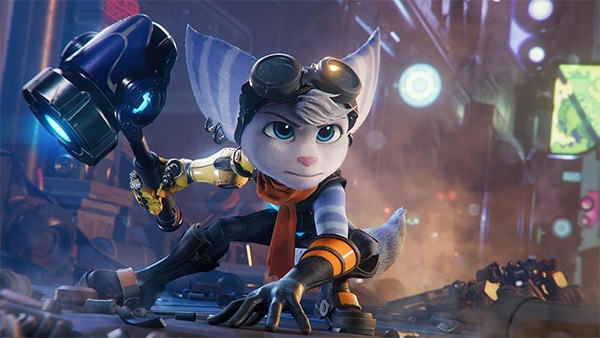Trending
Opinion: How will Project 2025 impact game developers?
The Heritage Foundation's manifesto for the possible next administration could do great harm to many, including large portions of the game development community.
Ratchet & Clank: Rift Apart's alternate universe heroes evolved from a very different design direction.

Ratchet & Clank: Rift Apart won the hearts of critics and fans with its slew of alternate-universe versions of its long-running cast. In the game, Ratchet and Clank cross paths with a female Lombax named Rivet and a robot named Kit--alternate versions of themselves from a mirror universe.
It's a big hook for the game that drives Insomniac Studios' innovative dimension-hopping rifts, and serves as a fun method for expanding the Ratchet & Clank cast. But according to creative director Marcus Smith, characters like Rivet and Kit started in a very different place.
During a post-2022 DICE Awards chat, Smith told Game Developer that Insomniac Games' initial strategy for fleshing out alternate dimension characters was that they would be "polar opposites" of the characters players already knew. "So if somebody is very adventurous, somebody else has to be very cowardly," he explained. A mirror version of the heroic Ratchet wouldn't also be heroic, they might be villainous or selfish.
It would have been a lot more like Star Trek's mirror universe than it is Sony Animation's Spider-Man: Into the Spider-Verse.
But that approach created problems as iteration on the game progressed. "The problem was--[we] very quickly realized our characters are not just two-dimensional characters that you can flip-flop for. We spent all of this time making these overly complex versions of anti-characters."
Smith said it ultimately "didn't work," and served to make Ratchet & Clank's returning characters "more flat."
Insomniac Games has a reputation for solid storytelling chops, but putting in the work to hone these characters apparently had other impacts.
We spoke to Smith and game director Mike Daly about having just won the prize for "best family game," an award that also was handed to the team for developing 2016's Ratchet & Clank. Daly said winning that award in 2016 took him by surprise, and turned out to be a "big deal" for how he thought about directing Ratchet & Clank games at Insomniac.
"When I started working on Rift Apart, there was always an idea in my mind that if we can make a great game that is accessible to the whole family, then that can have a much bigger impact than just delivering a great game."
He added that a lot of this kid-friendly focus was necessary in a dark moment for the robot character Kit. (Spoilers for Rift Apart below!)
Late in the game, Kit has an emotional breakdown over her guilt of harming her friend Rivet that results in her lashing out at the game's protagonists.
In response to a question from a reporter from The Washington Post in attendance about this moment--and how they made sure it wasn't too much for kids--Daly said that "There's a lot going on emotionally for that character...game design-wise, we had to strike a careful balance between [inviting players] to idolize this character and these traits they're hesitant to express, and how those traits manifest."
Smith offered a more personal take on that scene, saying he could personally relate to a character. "I've certainly lost my temper at times...[and then] felt bad for the people around me. That was a moment where I could be empathetic about what Kit was going through."
It's an admirable direction for a game to take; kids make it clear frequently that they respond to stories where the protagonists feel the same feelings they do, or make the same mistakes they make. For younger and older players alike, grappling with Kit's guilt and frustration had a payoff that mattered more to some folks than the prospect of hopping between dimensions.
You May Also Like